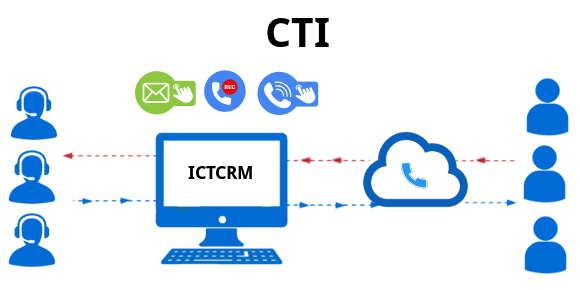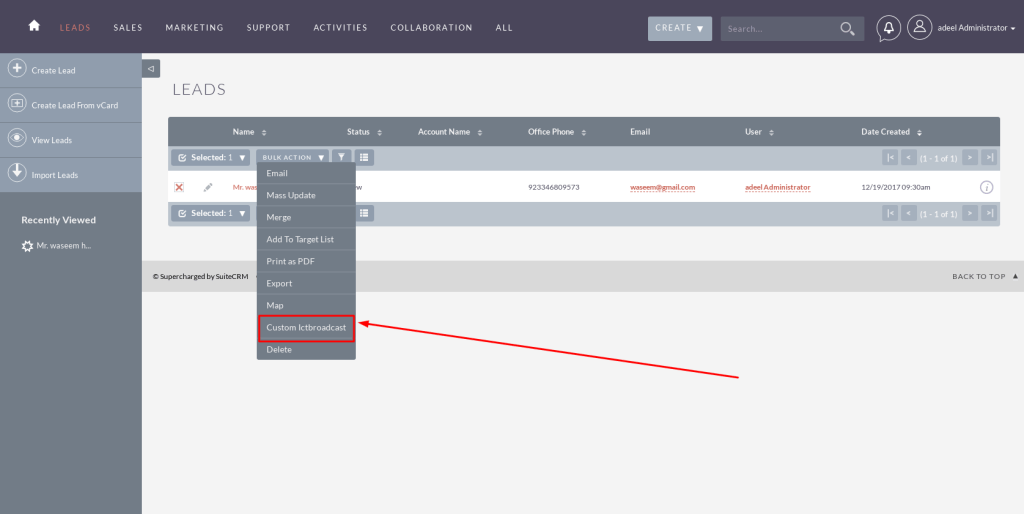Introduction:
On the other hand, CTI systems facilitate seamless communication by integrating telephony capabilities with CRM functionalities. This integration enables businesses to efficiently route calls, view customer information during conversations, and access call history. By having instant access to relevant customer data, employees can provide prompt and personalized assistance, resulting in improved customer satisfaction.
The combined power of CRM and CTI integration goes beyond streamlining customer interactions. It also enhances internal processes, making them more efficient and productive. With CRM and CTI working together, businesses can automate call logging, enable click-to-dial functionality, and automate call routing based on customer profiles or predefined rules. This automation reduces manual effort, minimizes errors, and optimizes resource allocation.
Furthermore, CRM and CTI integration enables comprehensive reporting and analytics. Businesses can generate insightful reports on call volumes, response times, customer satisfaction levels, and more. These analytics provide valuable data for continuous improvement, identifying areas for enhancement, and making data-driven decisions to enhance customer experiences.
In conclusion, integrating CRM with CTI technology empowers businesses to elevate customer engagement and satisfaction. By leveraging the capabilities of CRM systems alongside CTI functionalities, organizations can deliver personalized experiences, improve response times, and optimize internal processes. The result is enhanced customer relationships, increased loyalty, and a competitive edge in the market.

Understanding CRM and CTI:
Before delving into the benefits of combining CRM with CTI, let’s briefly define these two technologies.
1.1 Customer Relationship Management (CRM)
CRM software is a comprehensive solution that empowers businesses to effectively manage their customer interactions and relationships. By providing a centralized platform, CRM systems offer a range of features to store and organize customer data, track customer interactions, manage sales pipelines, and automate various customer-related processes.
The primary goal of CRM is to streamline and optimize the sales, marketing, and customer service activities of a business. It enables sales teams to track and manage leads, opportunities, and customer accounts, allowing for more efficient and targeted sales efforts. With CRM, businesses can analyze customer data and gain insights into customer preferences and behaviors, helping them tailor their marketing campaigns and strategies.
1.2 Computer Telephony Integration (CTI)
CTI, or Computer Telephony Integration, is the process of combining telephony systems with computer systems to enhance call management and improve customer interactions. By integrating telephony networks with CRM systems, businesses can seamlessly connect their phone systems with customer data and intelligence.
CTI integration enables businesses to capture essential customer information during phone calls, such as caller ID, call duration, and call recordings. This data is then synchronized with the CRM system, allowing for a comprehensive view of customer interactions and history.
The Synergy of CRM and CTI:
Combining CRM with CTI creates a powerful synergy that enhances customer engagement and satisfaction. Let’s explore some of the key benefits that this integration brings:
2.1 Improved Call Handling and Routing
By leveraging CRM with CTI, businesses can implement intelligent call routing based on customer data stored in the CRM system. This integration allows incoming calls to be automatically directed to the most suitable agent or department, based on the customer’s profile and preferences.
For instance, when a call comes in from a high-value customer, the CTI system can identify their status and route the call to a specialized agent who has access to their complete purchase history, preferences, and previous interactions. This ensures that the customer receives personalized and context-aware assistance, resulting in a higher level of satisfaction and increased loyalty.
2.2 Real-time Customer Insights
CTI integration allows businesses to gather real-time insights about customers during phone calls. The CRM system can display relevant customer information to agents before they even answer the call. This empowers agents to provide personalized and tailored solutions, leading to faster issue resolution and increased customer satisfaction. Agents can access previous interactions, purchase history, and any ongoing issues, enabling them to deliver a seamless and informed customer experience.
2.3 Streamlined Workflows and Automation
CRM with CTI enables businesses to automate repetitive tasks and streamline workflows. For example, when a customer calls for a specific request, the CTI system can automatically display relevant screens and prompt the agent with suggested responses based on previous interactions. This automation reduces agent effort and increases efficiency, allowing them to focus more on building relationships and delivering value to customers.

2.4 Enhanced Sales and Cross-Selling Opportunities
Through the integration of CRM with CTI, businesses can leverage phone conversations to identify cross-selling and upselling opportunities. The CRM system analyzes customer data, including purchase history and preferences, to suggest relevant products or services during the call.
When a customer is on the phone, agents can receive real-time notifications from the CRM system about ongoing promotions, discounts, or special offers. Armed with this information, agents can proactively present personalized deals to the customer, increasing the likelihood of additional sales and enhancing the overall customer experience.
This integration enhances sales effectiveness by providing agents with timely and relevant information to guide their conversations and offer tailored recommendations. By leveraging customer data and contextual insights, businesses can deliver a more personalized and targeted sales approach, increasing the chances of upselling and cross-selling success.
2.5 Improved Call Analytics and Reporting
CTI integration provides businesses with valuable call analytics and reporting capabilities. Managers can access detailed reports on call volumes, call durations, call outcomes, and customer satisfaction ratings. These insights help identify bottlenecks, optimize call handling processes, and measure the effectiveness of customer service efforts. By leveraging data-driven decision-making, businesses can continually improve their customer engagement strategies and ensure high levels of customer satisfaction.
Real-world Applications and Success Stories:
CRM with CTI integration has been widely adopted across various industries, and numerous success stories highlight its impact on customer engagement and satisfaction. Let’s explore a few real-world applications:
3.1 Call Center Optimization
In call center environments, CRM with CTI integration has proven to be a game-changer. Agents can access comprehensive customer profiles and call histories, enabling them to handle inquiries more efficiently. Intelligent call routing ensures that customers are connected to the most appropriate agent, reducing call transfers and wait times. This optimization results in improved first-call resolution rates and enhanced customer satisfaction.
3.2 Proactive Customer Support
With CRM and CTI integration, businesses can take a proactive approach to customer support. By analyzing call patterns and customer data, companies can identify potential issues or customer dissatisfaction before they escalate. Agents can then reach out to customers proactively, addressing their concerns and resolving problems swiftly. This approach not only strengthens customer relationships but also helps prevent churn and increase customer loyalty.
3.3 Personalized Sales and Marketing Campaigns
The integration of CRM with CTI empowers businesses to deliver highly personalized sales and marketing campaigns. By leveraging customer call interactions, purchase history, and preferences, companies can segment their customer base and tailor their offers accordingly.
Through CRM with CTI integration, agents have access to real-time insights and personalized recommendations during sales calls. Armed with this information, they can engage customers in targeted discussions, highlighting products or services that align with their specific needs and interests. This level of personalization not only increases the likelihood of conversions but also enhances customer satisfaction by demonstrating a deep understanding of their preferences.
Challenges and Considerations:
While CRM with CTI integration offers significant benefits, it’s essential to consider some challenges and considerations:
4.1 Data Security and Privacy
Integrating CRM with CTI requires careful consideration of data security and privacy. Call recordings and customer data must be handled in compliance with relevant regulations, such as GDPR (General Data Protection Regulation). Businesses must ensure robust security measures are in place to protect customer information and prevent unauthorized access.
4.2 Integration Complexity
Integrating CRM with CTI can be a complex process, especially when dealing with legacy systems or multiple telephony providers. It requires coordination between IT teams, CRM vendors, and telephony providers to ensure a seamless integration. Adequate planning, testing, and ongoing support are crucial to overcoming integration challenges.
4.3 Agent Training and Adoption
To fully leverage CRM with CTI integration, agents need comprehensive training on both the CRM system and CTI functionalities. They should understand how to utilize the integrated tools effectively, interpret customer data, and deliver personalized experiences. Ensuring proper training and adoption is vital for maximizing the benefits of this integration.
The Future of CRM with CTI
As technology continues to evolve, the future of CRM with CTI looks promising. Advancements in artificial intelligence and natural language processing will enable even more intelligent call routing and real-time sentiment analysis. Voice analytics capabilities will provide businesses with deeper insights into customer behavior and preferences. Additionally, the integration of CRM with emerging communication channels, such as messaging apps and social media platforms, will further enhance customer engagement and satisfaction.
Conclusion:
CRM with CTI integration has transformed the way businesses engage with their customers, providing personalized experiences and exceptional service. By combining the power of CRM systems with telephony integration, companies can streamline workflows, gain real-time customer insights, and drive sales effectiveness. The success stories and real-world applications of CRM with CTI demonstrate its significant impact on customer engagement and satisfaction. As businesses continue to prioritize customer-centric strategies, CRM with CTI will remain a game-changer, helping them build lasting relationships and thrive in today’s competitive marketplace.
Leveraging Open Source in ICT
